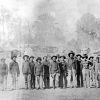calsfoundation@cals.org
Scout to Grand Glaize
A force of the Fourth Missouri Cavalry (US) was sent to Grand Glaise (Jackson County) on May 14, 1862, as the Union’s Army of the Southwest sought intelligence on Confederate movements as the Federal army menaced Little Rock (Pulaski County) during the midpoint of the 1862 Pea Ridge Campaign.
Following the Union victory at Pea Ridge on March 7–8, 1862, Major General Samuel R. Curtis pulled his Army of the Southwest back into Missouri to protect that border state from other possible incursions by Confederate troops. By late April, though, Curtis’s commander, Major General Henry Halleck, concluded correctly that Major General Earl Van Dorn had moved his Confederate Army of the West across the Mississippi River, so he ordered Curtis to return to Arkansas with the goal of capturing the capital at Little Rock.
Curtis entered Arkansas near Salem (Fulton County) on April 29 and marched to Batesville (Independence County), arriving there on May 2. Brigadier General Frederick Steele brought a separate Union army from southeastern Missouri and occupied Jacksonport (Jackson County) on May 4, and Curtis incorporated those troops into the Army of the Southwest, reorganizing the army into three divisions, with Steele commanding the First Division, Brigadier General Eugene Carr leading the Second Division, and Colonel Peter J. Osterhaus at the head of the Third Division.
On May 7, Osterhaus led his troops south from Batesville, arriving at the Little Red River four days later. The Third Division was in a precarious position, being separated from the other two even as reports came in that Confederate major general Thomas C. Hindman was commandeering Texas troops passing through Arkansas and authorizing the formation of partisan bands to attack and harass Union troops while Confederate gunboats were supposedly active on the White River. The Federal troops soon began scouring the countryside for information and provisions.
On May 14, Osterhaus sent a patrol of the Fourth Missouri Cavalry (US) under Major Eugene Kielmansegge to Grand Glaise to investigate reports of gunboats and Confederate troops in the area. The cavalrymen surrounded the town around 10:20 a.m. on May 14 and determined that gunboats anticipated in the area were Union, not Confederate, and rumored to be transporting supplies. They also learned that a party of fifteen to twenty men from Searcy (White County) lawyer William T. Hicks’s partisan company, led by a Lieutenant Pope, had passed through Grand Glaise three days earlier on a circuit to Jacksonport and back to Searcy. Kielmansegge also reported that heavy cannon fire had been heard northeast of Grand Glaise on May 10 and 11. The party of the Fourth Missouri returned to the Union base on the evening of May 14.
Confederate activity in the area increased, and Union foraging parties had greater contact with them in the days following the scout to Grand Glaise, including the Skirmish at Little Red River on May 17 and the brutal Action at Whitney’s Lane two days later, both of which involved troops of Hicks’s command.
The Union drive on Little Rock was ultimately abandoned because of the tenuousness of the supply line from Missouri, and the Union troops who had threatened the capital were ordered back to Batesville on June 4. Following the failure of a supply flotilla to reach the Army of the Southwest after the Engagement at St. Charles, Curtis decided to live off the land and march across eastern Arkansas to Helena (Phillips County), which he reached on July 12, 1862, ending the Pea Ridge Campaign.
For additional information:
Akridge, Scott H., and Emmett E. Powers. A Severe and Bloody Fight: The Battle of Whitney’s Lane & Military Occupation of White County, Arkansas, May & June, 1862. Searcy, AR: White County Historical Museum, 1996.
Christ, Mark K., ed. Rugged and Sublime: The Civil War in Arkansas. Fayetteville: University of Arkansas Press, 1994.
Shea, William L., and Earl J. Hess. Pea Ridge: Civil War Campaign in the West. Chapel Hill: University of North Carolina Press, 1994.
The War of the Rebellion: A compilation of the Official Records of the Union and Confederate Armies, Series I, Vol. 13, pp. 385–386. Washington DC: Government Printing Office, 1885.
Mark K. Christ
Central Arkansas Library System
 Civil War Timeline
Civil War Timeline Military
Military




Comments
No comments on this entry yet.